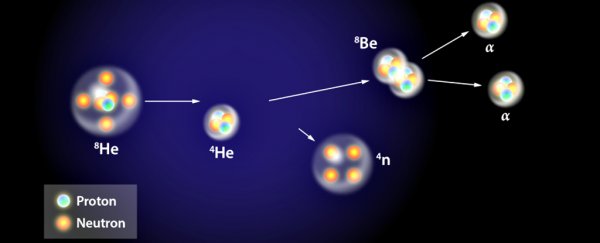In February this year, Japanese researchers rocked the physics world when they claimed they'd finally confirmed the existence of a mysterious, and long-thought impossible 'four-neutron, no-proton' particle, known as a tetraneutron.
And now a study adds more evidence that they were right, showing that not only can the tetraneutron exist stably, but that it should look a whole lot like the particle that was observed by the Japanese team - taking us a step closer to confirming the existence of a new subatomic structure.
If further independent observation can verify the presence of the tetraneutron, it would be a huge deal, because scientists have been trying to find the mysterious structure for 40 years, despite claims that it couldn't possibly exist. But there has been very little evidence to go off until now.
It would be such a big deal, in fact, that it would require a rewrite of our current models of nuclear force - the force that holds protons and neutrons together.
"It would be something of a sensation," nuclear theorist Peter Schuck from France's National Centre for Scientific Research, who wasn't involved in the research, told Science News back in February.
So what is a tetraneutron, and why are so many researchers sure it doesn't exist? The hypothesised structure is made up of a cluster of four neutrons - subatomic particles that have mass, but no charge. Along with protons, neutrons make up the nucleus of atoms.
On their own, though, neutrons are highly unstable, and will convert into positively charged protons after just 10 minutes.
And groups of two or three neutrons together are even more unstable - which is why it's been long thought that the existence of a tetraneutron is impossible.
But there have been tell-tale signs of it over the years.
Since a 1965 paper concluded that "the existence of tetraneutrons is most unlikely", four separate papers have reported experimental observations of the particle - although none of them have been able to be replicated.
But in February this year, a team of researchers from RIKEN and the University of Tokyo fired a beam of neutron-rich helium-8 nuclei (which has two protons and six neutrons) at liquid helium (which has two protons and two neutrons).
In the resulting fallout of the collision, they found that four neutrons went missing.
Their absence only lasted around 1 billionth of a trillionth of a second before they reappeared as particle decay - but during that absence, the researchers calculated that it was most likely that the four neutrons had bound together to form a tetraneutron.
As promising as that research was, there was the remaining, and not insignificant, problem that no one had had been able to show that tetraneutrons were even possible according to our current understanding of the nuclear force that holds particles together.
But now a team of physicists from the Iowa State University has been able to show through new computer simulations that four neutrons actually can exist stably for a period of time before decaying.
That period of time is only 5×10-22 seconds - a tiny fraction of a billionth of a nanosecond - but that's long enough that researchers will be able to study the tetraneutron, and try to figure out what type of strong force is holding them together.
"This opens up a whole new line of research," said lead researcher James Vary. "Studying the tetraneutron will help us understand interneutron forces including previously unexplored features of the unstable two-neutron and three-neutron systems."
The team's simulations of the structure's energy and size also corroborate the Japanese researchers' observation of the new subatomic structure - which means the properties predicted by these new simulations were consistent with what the team in Japan saw before the tetraneutron decayed.
The next step is for more independent teams to start smashing atoms together to see if they can also find direct evidence of the tetraneutron. And these new simulations will narrow down what they're looking for.
"We know that additional experiments with state-of-the-art facilities are in preparation with the goal to get precise characteristics of the tetraneutron," said Vary. "We are providing our state-of-the-art predictions to help guide these experiments."
If the existence of the tetraneutron can be confirmed, it'll add a fascinating entry to the chart of nuclides - which is like a Periodic Table of all known nuclei and their isotopes.
It could also lead us to rewriting our models of nuclear force, and change our understanding of how subatomic particles are held together.
Right now, the only confirmed neutron structure we know of in the Universe are neutron stars - small but dense stars that are thought to be made almost entirely of neutrons, and form after the collapse of massive stars after a supernova explosion.
These stars are only about 11 km (7 miles) in radius, but they're estimated to have a mass similar to that of our Sun - and are made up of around 1057 neutrons, all bound together.
If the tetraneutron is discovered, it'll help us figure out how these incredible stars form - and maybe even why they have some bizarre similarities with human cells.
We're looking forward to seeing what happens next.
The research has been published in Physical Review Letters.
